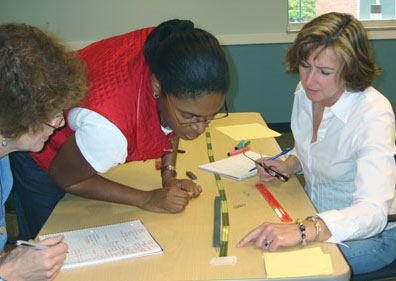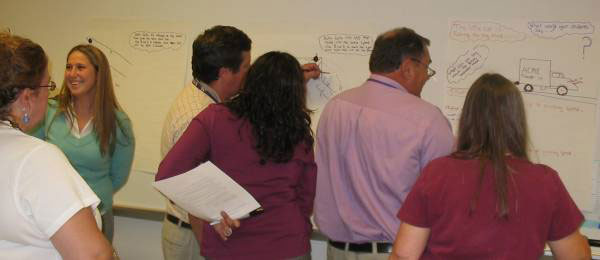Online Professional Development opportunities currently available (for K-8):
Theories in Science (7 hr PD)
| I. | How Do We Know if a Theory Has Scientific Merit? |
| II. | Cooling by Boiling |
| III. | Making Ice Cream |
| IV. | Floating and Sinking |
| V. | Atomic Theories |
Light and Color (3 hr PD)
Participants will investigate some basic principles about light and color. Four ways to produce color will be investigated. Some questions that will be addressed are: Why is the sky blue? Why do we see red sunsets? Why are leaves green and tomatoes red? Why are lakes blue? How do sodium lamps work? How does a breath-a-lizer work? How do we test for lead in our water?
I. General Principles
- Monochromatic Light and our Eye
- Color Wheels
- Primary Colors
- Filters - Drawing Pictures
II. Selective Emission
- Creating Monochromatic Light - Background
- Gas Discharge Tubes and Color
- Determining Sodium in Water
III. Selective Absorption
- Red Tomatoes!
- Green Leaves, Blue Lakes
- Filters - uv-vis instrument?
- Breath-a-lizer
- IR
IV. Selective Scattering
- Scattering Light
- Blue Sky
- Red Sunset
V. Selective Reflection
- Gold
- Monitor Applications
Science Math (5 hr PD)
| I. | Understanding Basic Mathematical Reasoning in Physical Science |
|
A. Arithmetic and Basic Algebra in physical science
B. Reporting Numbers - How do we know when data is significant?
C. Understanding Equations - Where do equations come from?
D. Tables, Graphs, and Equations - How are they connected?
|
| II. | Understanding Graphs in Physical Science |
|
A. Basic Graphing Review
B. Interpreting Graphs in Physical Science
C. Predicting Graphs in Physical Science
D. Combining Graphs for real physical situations
|
| III. | Application: Investigating a car wreck.
|
|
A. Motion without acceleration.
B. Motion with acceleration due to friction.
|
|
|
Balls and Ramps (6 hr PD)
Motion along an incline is investigated.
Basic Chemical Principles, CHE901 (1 Credit)
Participants will investigate some basic chemical principles that govern many everyday observations in the physical world.
| I. | Matter and Atoms |
|
A. Matter and Elements
B. History of Atomic Theory to Raisin Pudding Model
C. Gold Foil Experiment
D. Discrete Energy Levels
E. Probability and Quantum Theory
|
| II. | Making Compounds |
|
A. Charges and Charge Interactions
B. Elements and Atomic Number
C. Periodic Table Columns
D. Electrons and Reactions - Inert Gases
E. Transferring Electrons - Ions
F. Formulas for Ionic Compounds
G. Bases Using The Hydroxide Ion
|
| III. | Making Molecules |
|
A. Covalent Bonds
B. Acids - Covalent, But Give Ions in Aqueous Solutions
C. Nonpolar Molecules
D. Polar Molecules
E. Intermolecular Forces
|
Math in Science, PHY901 (1 Credit)
Participants will investigate basic mathematical principles as applied and used in the Physical Sciences. The ability to use mathematical concepts will be developed by using them to better understand physical phenomena. Students will better understand and appreciate the role of the following mathematical concepts as they apply to the physical sciences: numbers viewed as experimental data, tables, graphs, and equations.
| I. | Understanding Basic Mathematical Reasoning in Physical Science |
|
A. Arithmetic and Basic Algebra in physical science
B. Reporting Numbers - How do we know when data is significant?
C. Understanding Equations - Where do equations come from?
D. Tables, Graphs, and Equations - How are they connected?
|
| II. | Understanding Graphs in Physical Science |
|
A. Basic Graphing Review
B. Interpreting Graphs in Physical Science
C. Predicting Graphs in Physical Science
D. Combining Graphs for real physical situations
|
| III. | Application: Investigating a car wreck.
|
|
A. Motion without acceleration.
B. Motion with acceleration due to friction.
|
| IV. | Application: Balls and Ramps
|
|
|
Physical Science Investigations, PHY902 (1 Credit)
Participants will study puzzling observations drawn from the physical world and identify the physical science principles that underlie and describe the behavior of the phenomena in question. Strategies for scientific investigations will be developed as the course progresses. The role of intermediate theories and student beliefs will also be incorporated into the investigations.
| I. | How Do We Know if a Theory Has Scientific Merit? |
| II. | Cooling by Boiling |
| III. | Making Ice Cream |
| IV. | Floating and Sinking |
| V. | Atomic Theories |
| VI. | Light and Color |
Other online Professional Development opportunities (for 9-12):
Chemical Equations and Stoichiometry, CHE902 (1 Credit)
Participants will build on basic chemical principles to investigate chemical equations.
| I. | The Mole |
| II. | Chemical Equations |
| III. | Unit Conversions |
| IV. | Molar Mass |
| V. | Simple Stoichiometry |
| VI. | Limiting Reactants |
| VII. | Molarity |
High Tide Opposite the Moon, PHY905 (1 Credit)
Participants will build a background to understand how a high tide can be formed on the side of the earth opposite the moon.
| I. | Linear Motion - Why does the coin roll so far? |
|
A. Motion Without Acceleration - Why we slam into the windshield
B. Acceleration Due to Friction - Investigating car wrecks
C. Acceleration Due to Gravity - How to determine the depth of a deep hole
D. Combining Horizontal and Vertical Motion - Dropping CARE packages from airplanes
|
| II. | Circular Motion - How to deviate from straight line motion |
|
A. Centripetal Force - How to keep dry under a rotating bucket of water
B. Centrifugal Force - Does it really exist?
|
| III. | Tides - The attraction between earth and moon? |
|
A. Gravity - Is there gravity on the moon?
B. High Tide Opposite the Moon - How does that work?
|
Other online Professional Development ideas:
- Determining if a theory has scientific merit.
- Choosing between two theories that both have merit.
- How to generate scientific theories.
- The parameters of good science experiments.
- Balls racing down different shaped tracks.
- Bell and dropper experiment.
- Conservation of energy.
- Etc.

